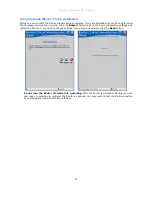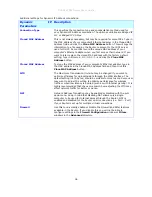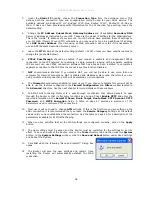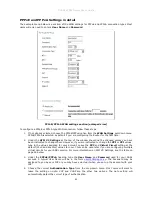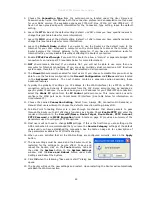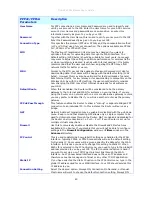
DSL-504T DSL Router User’s Guide
45
The table below provides a description of the ATM settings for traffic shaping.
ATM
Parameters
Description
Service Category
The ATM settings allow the user to adjust ATM Quality of Service (QoS) or traffic
parameters to suit specific traffic requirements. For applications or circumstances
where packet loss or packet delay is a concern, ATM QoS can be adjusted to
minimize problems. For most accounts, it will not be necessary to change these
settings. Altering QoS settings can adversely affect performance of some
commonly used Internet applications.
If you plan to change QoS or traffic parameters, contact your ISP or network
services provider for information on what types of adjustment are available or
possible for your account. Your ISP may not support the class of service you
want to use.
To adjust ATM QoS parameters, select one of the Service Categories listed here
and type in the PCR value in the entry field below. For the VBR service category,
an additional parameter (SCR) must also be defined.
UBR – Unspecified Bit Rate, this is the default category used for general-purpose
Internet traffic where normal levels of packet loss and delay are acceptable. For
some applications or for multiple connection accounts, it may be desirable to
specify the PCR.
CBR – Constant Bit Rate, usually used in circumstances where very low packet
loss and very low Cell Delay Variable (CDV) are desirable.
VBR-nt – Real-time Variable Bit Rate. This models bursty traffic with specified
peak and sustainable rates. Please note that when VBR-rt is specified, both PCR
and SCR are required (by ATM standards).
VBR-nrt – Non-real-time Variable Bit Rate, usually used when network traffic is
characterized by bursts of packets at variable intervals, and some moderate
packet loss and delay is acceptable. This category is typically used for audio and
video applications such as teleconferencing. The network must support QoS Class
2 to use VBR-nrt.
PCR
Peak Cell Rate – The PCR is inversely related to the time interval between ATM
cells. It is specified for all three service categories (UBR, CBR and VBR) in Kbps.
SCR
Sustainable Cell Rate – The SCR is defined for the VBR service category. This is
the rate that can be sustained for “bursty”, on-off traffic sources. It is a function
of Maximum Burst Size (MBS) and the time interval (between cells).
CDVT
Cell Delay Variation Tolerance – CDVT is a measure of the cell clumping
phenomenon by which cells are delayed in the network and are
clumped together and arrive at a system at a faster rate than negotiated.
Increasing the CDVT creates greater bucket depth.
MBS
Maximum Burst Size – The MBS is the maximum number of bytes that can be
sent continuously from the source to the destination dropping any packets. Some
ATM providers set the MBS and CDVT very low and adjust up if problems occur.
Содержание DSL-504T
Страница 1: ...DSL 504T ADSL Router User Guide January 2007 ...
Страница 19: ...DSL 504T DSL Router User s Guide 11 Click the start installation button Click the NEXT button ...
Страница 20: ...DSL 504T DSL Router User s Guide 12 Click the NEXT button Click the NEXT button ...
Страница 64: ...DSL 504T DSL Router User s Guide 56 ...

